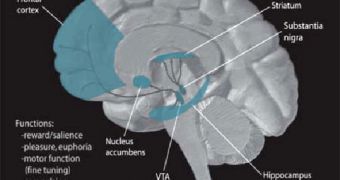The brains of drug addicts and binge eaters share a number of mechanisms in common, researchers argue in a new study. The paper reveals how the brains of binge eaters are primed to experience rewards similarly to how drug addicts do, when they are exposed to the sight or smell of food.
The way this is done, the science group behind the work explains, is by triggering the release of massive amounts of dopamine. This chemical is also involved in the way people feel rewarded when consuming drugs, smoking or drinking alcohol.
In the new experiments, the goal was to tease out the slight differences that set apart ordinary obese individuals from those who become fat because they constantly and compulsively overeat (binge).
Scientists with the US Department of Energy’s (DOE) Brookhaven National Laboratory (BNL) used brain-imaging technologies to try and make sense of the way the test participants' brains responded to a variety of stimuli.
Generally, dopamine plays a role in reward and motivation, and works by smoothing and improving the connections between individual nerve cells in the human brain. It is produced in larger quantities when people are having fun, and helps associate a behavior with a reward.
The study resolved that, whenever dopamine levels spiked in binge eaters, they triggered compulsive overeating nearly all the time, PsychCentral reports. Details of the work appear in the latest issue of the esteemed scientific journal Obesity.
A radiotracer was used to detect dopamine levels in participants who were obese, or binge eaters. When the latter group was exposed to food stimulation, their dopamine levels spiked. In the other group, they remained normal.
“These results identify dopamine neurotransmission, which primes the brain to seek reward, as being of relevance to the neurobiology of binge eating disorder,” explains the lead author of the new study, Gene-Jack Wang, MD.
“These results provided evidence of a conditioned-cue response to food,” the expert adds.
“Understanding the neurobiological mechanisms underlying food stimulation might point us toward new ways to help individuals regulate their abnormal eating behaviors,” he goes on to say.
The BNL team used an imaging technique called positron emission tomography (PET) to determine how much dopamine binds to specific receptors in the brains of all participants.

 14 DAY TRIAL //
14 DAY TRIAL //